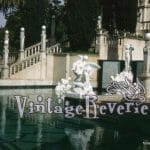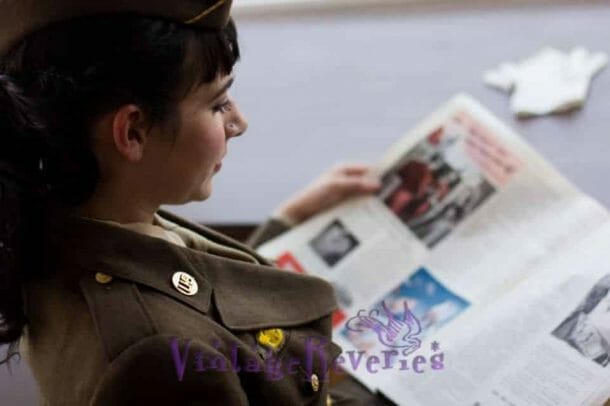
Edwardian Lace Dress on Model Anita

In the early 1900s, before the sweeping changes brought by World War I and the Roaring Twenties, fashion spoke the language of refinement, delicacy, and meticulous detail. The Edwardian period (1901–1910), also known as the “Belle Époque,” celebrated opulence and grace. It was during this time that women’s clothing centered on delicate fabrics, intricate embellishments, and an emphasis on feminine silhouettes.
The dress featured in this photoshoot embodies these ideals. Pictured here is the timeless elegance of an Edwardian lace dress, modeled by Anita at the Carondelet Historical Society. What truly stands out is the striking craftsmanship of this garment, which would have been made by hand—a laborious process involving hours of intricate lacework and fabric manipulation. This particular lace dress is a rare piece, showcasing the artistry of early 20th-century fashion. The delicate lace, soft draping, and fluidity of the garment reflect a time when clothing was a combination of art, status symbol, and personal expression.
I posed Anita with an original interior design book from 1912, drawing attention to the harmony between fashion and other areas of design from that period. The Edwardian era was marked by an appreciation for beauty in all its forms—whether it was in architecture, clothing, or interior decoration. Heavily influenced by the Art Nouveau movement, people of this era embraced floral designs, curling patterns, and other organic elements reminiscent of nature. As Anita holds this book, it connects the dots between two powerful expressions of early 20th-century aesthetics.
Edwardian Elegance: Corsets and the Changing Silhouette
One interesting note about this particular shoot is that Anita, being naturally petite, was able to wear this dress without the assistance of a corset. Corsets, synonymous with the Edwardian era, were a crucial part of a dress like this, shaping the torso to achieve the desired S-curve silhouette—a departure from the hourglass figure of the Victorian period. The S-curve shape, characterized by a straight-fronted bodice and a backward-thrust waist, reflected the ideals of feminine beauty during that time. These tightly laced corsets created an elegant posture and accentuated the flow of the dress’s fabric.
Although we didn’t have a corset available for this shoot, this doesn’t diminish the beauty of how the lace dress draped over Anita’s frame. In fact, it’s a testament to the versatility of this design. The flowing lace and gentle structure of the garment ensured that it could be appreciated across different body types, even without the structural underpinnings that were often used in the Edwardian era.
The Timeless Art of Lace
Lace, the star of this dress, was highly sought after during the Edwardian period. It was a luxurious fabric, reserved for special occasions or wealthy women who could afford such finery. For many, an Edwardian lace dress was the epitome of elegance and femininity. Various types of lace were popular during this time, including Chantilly, Alençon, and Irish crochet lace. Each piece of lace often required weeks or even months to craft, and owning garments featuring these delicate textiles was a sign of prosperity and good taste.
The lacework on this dress highlights the astonishing level of detail that exemplifies Edwardian clothing. Each delicate thread and floral embellishment reflects a bygone era when garments were not only functional attire but works of art. Unlike modern clothing, which often leans heavily on machine manufacturing, this dress speaks to a time when clothing was individually tailored. The craftsmanship ensured a fit unique to the wearer while reflecting their social standing and style choices.
Photoshoot Reflections
In this Edwardian-themed shoot, I intentionally opted not to edit the resulting photos heavily. The untouched images bring authenticity to the project, allowing the raw beauty of the time-period styling to shine through. Anita’s natural elegance pairs beautifully with the vintage piece, and the lack of heavy re-editing draws attention to the textures and light interplay across the lace. Photographed inside the Carondelet Historical Society, the setting adds another layer of depth, presenting a perfect backdrop to complement the vintage theme.
It’s worth noting how Anita’s petite frame emphasizes the tiny silhouettes common during the Edwardian period. Women were often perceived as delicate beings, and clothing like this lace dress reinforced societal ideals of fragility and elegance. As I reflect on the shoot, I can’t help but imagine how this garment might have been worn over a hundred years ago—possibly to a garden party, formal tea, or social event by a woman eager to showcase her fashion sense.
Inspirations and Details
During the shoot, I paired the dress with an interior design book from 1912. The idea was to showcase how design—whether in clothing or interiors—shared common themes of intricacy and natural motifs during this period. This book, which I plan to scan before selling, provides fascinating insights into home aesthetics of the time, another testament to the artistry woven into everyday life back then.
When thinking about Edwardian life, it’s easy to romanticize the beauty of the clothing and design, but it’s also important to understand the context. This was a transitional period, as the world was on the brink of major social, political, and technological change. The extravagant fashion of the Edwardian era would soon give way to the more practical and less restrictive styles of the 1920s, as women gained new freedoms and societal roles shifted.
The Dress’s Legacy
As I worked on this project, I found myself in awe of the delicate beauty of this lace dress. It stands as more than just a piece of clothing; it’s a portal into another time. From the craftsmanship to the cultural relevance, this Edwardian piece encapsulates an era defined by beauty, artistry, and elegance. It’s staggering to think about how many memories and stories such a garment may hold.
Fashion historians often say that clothing can tell us just as much about the past as books. This lace dress, with its whispery details and elegant flow, is no exception. It transports not only the wearer but also the observer back to a time when the world was slower, and beauty was found in the minute details.
For now, though, it exists here—as a centerpiece of a vintage shoot, a small but powerful reminder of a dazzling chapter in fashion history.


























You must be logged in to post a comment.